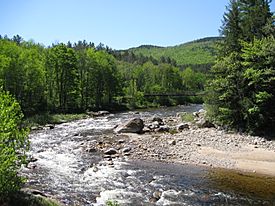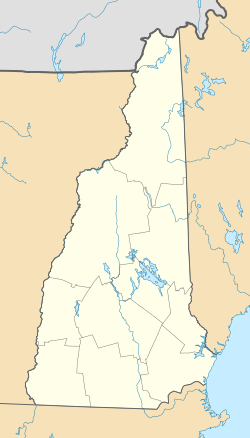Wild River (Androscoggin River tributary) facts for kids
Quick facts for kids Wild River |
|
|---|---|

The Wild River at Hastings, Maine
|
|
| Country | United States |
| States | New Hampshire, Maine |
| Counties | Carroll, NH; Coos, NH; Oxford, ME |
| Towns and townships | Jackson, NH; Bean's Purchase, NH; Shelburne, NH; South Oxford, ME; Gilead, ME |
| Physical characteristics | |
| Main source | Black Mountain Jackson, NH 2,810 ft (860 m) 44°13′51″N 71°9′0″W / 44.23083°N 71.15000°W |
| River mouth | Androscoggin River Gilead, ME 678 ft (207 m) 44°23′45″N 70°58′45″W / 44.39583°N 70.97917°W |
| Length | 17.2 mi (27.7 km) |
| Basin features | |
| Tributaries |
|
The Wild River is a river that flows for about 17 miles (27.7 kilometers) through the beautiful White Mountains. These mountains are located in both New Hampshire and Maine in the United States. The Wild River is a smaller stream that eventually joins a larger river called the Androscoggin River. The Androscoggin River then flows towards the Atlantic Ocean.
Contents
Where Does the Wild River Flow?
The Wild River starts its journey on the northern side of Black Mountain. This mountain is in the town of Jackson, New Hampshire. From there, it flows northeast, entering an area called Bean's Purchase. Along the way, it picks up water from No Ketchum Pond.
The river continues its path through a mountain valley. This valley is nestled between two mountain ranges: the Carter-Moriah Range on one side and the Baldface-Royce Range on the other. The Wild River then briefly crosses the corner of Shelburne, New Hampshire. After that, it enters the state of Maine.
In Maine, the river meets Evans Brook. This brook flows from a high point in Evans Notch, which is near the old logging town of Hastings. Maine Highway 113 follows Evans Brook and then runs alongside the Wild River. This road goes from Hastings north to Gilead. In Gilead, the Wild River finally joins the Androscoggin River. You can see the Wild River bridged by U.S. Route 2 and the St. Lawrence & Atlantic Railroad in Gilead.
A Look Back: Early Days of the Wild River
Long ago, European settlers traveled into this area from Fryeburg, Maine. They followed the Cold River valley, went through Evans Notch, and then down Evans Brook to Gilead. Evans Notch and Evans Brook were named after Captain John Evans. He led European soldiers against the native people in 1781.
The town of Gilead officially became a town in 1804. A railroad, called the Atlantic and St. Lawrence Railroad, was built from Portland to Montreal. It followed the Androscoggin River and reached Gilead in 1851. This railroad bridge was very strong. It was the first river crossing that could handle the strong water flow during big storms. Building water-powered mills next to the river was also hard because of these powerful water events. Work on the road now known as Maine Highway 113 began in 1866.
In 1882, a man named Major Gideon Hastings bought large areas of forest land. He then started his company, the Hastings Lumber Company.
The Wild River Railroad: A Journey Through Time
In 1891, a special railroad was built. It followed what is now Route 113, going from Gilead to the Hastings lumber mill. This mill was on Evans Brook, close to where it met the Wild River. Ten houses were built along the Wild River for the company's workers at Hastings. People called these houses "the ten commandments."
By 1896, the railroad tracks stretched about 10 miles (16 kilometers) up the Wild River. There were also smaller tracks that branched off to streams like Bull Brook, Blue Brook, and Spruce Brook. But in 1903, a huge wildfire swept through the area. It destroyed all the trees that had not yet been cut down. Because of this, the railroad was taken apart in 1904.
Between 1912 and 1918, the land owned by the lumber company was bought to become part of the White Mountain National Forest. Later, in December 2006, a law called the New England Wilderness Act was passed. This law made about 23,700 acres (9,591 hectares) of the Wild River area a special protected place called the Wild River Wilderness.
Locomotives of the Wild River Railroad
These are the engines that pulled trains on the Wild River Railroad:
| Number | Name | Builder | Type | Date | Works number | Notes |
|---|---|---|---|---|---|---|
| 1 | Gilead | Lima Locomotive Works | 2-truck, 3-cylinder Shay | 30 September 1891 | 370 | purchased new - destroyed by boiler explosion 18 April 1899 |
| 2 | Portland Company | 4-4-0 | 1871 | 202 | formerly Portland and Ogdensburg Railway #4 Hyde Park - replaced by # 4 and boiler used in the wood alcohol mill of the Hastings Chemical Company | |
| 3 | Lima Locomotive Works | 2-truck, 3-cylinder Shay | 10 November 1896 | 523 | built as Success Pond Railroad # 6; leased from Blanchard & Twitchell Company of Berlin, New Hampshire to replace # 1; went to White River Railroad of Woodstock, Vermont when Wild River Railroad was dismantled | |
| 4 | Baldwin Locomotive Works | 2-4-2 Tank locomotive | 1900 | 17433 | purchased new to replace # 2 - sold to Berlin Mills Railroad in 1904 |
Fun and Adventure: Exploring the Wild River
During the summer and early fall, the Wild River can become very shallow, almost like a small stream. However, it is home to native brook trout. These fish are known to bite small dry flies, which makes them a favorite for people who enjoy fly fishing.
The Wild River Trail follows the path of the old railroad tracks along the river. If you plan to visit in early spring or late fall, be careful! Route 113 is not kept clear during the winter. It can be a very long drive if you arrive and find the road closed. The famous Appalachian Trail also runs along the top of the Carter-Moriah Range, which is on the western side of the Wild River area.




